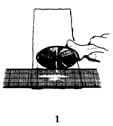Read Pie and Pastry Bible Online
Authors: Rose Levy Beranbaum
Pie and Pastry Bible (138 page)


Starting ½ inch from the top and ½ inch from the left side of each square, pipe or spread a column of remonce, ending ½ inch from the bottom edge. (Figure 2) Brush egg wash over the right side of each strip from the edge up to the filling. Bring the left side of each dough square up and over the filling so the entire ½-inch border rests on the egg-washed dough. Press it down onto the dough so that it will adhere. (Figure 3) Fold over the right side of each dough square so that it comes just to the edge of
the column of filling. (It will overlap the other edge by ½ inch.) Press firmly on this overlap and on the bottom and top edges of the dough so the dough adheres and the filling is sealed. (Figure 4) The pastries will now be about 4 inches long by about 1¾ inches wide.

Use a small sharp knife to cut slashes about ½ inch long and ¼ inch apart along the right side of the dough, where there is no filling. (Be sure not to cut up to the filling, or it will leak.) (Figure 5)

Turn each pastry seam side down and arrange them so that they are close together on the counter. Brush them with egg wash and sprinkle them with the pearl sugar and sliced almonds. Pick up each bear claw, shaking off any nuts that do not adhere, arch it into a crescent, so that the cuts open, and set the pastries at least 2 inches apart on the prepared baking sheets, maintaining the open cuts and arch. Press any fallen nuts onto the dough. (The nuts can be quite close together, as the expanding dough during rising and baking will move them farther apart.) (Figure 6)

If you have two 2-inch-deep 18-inch sheet pans, invert them over the bear claws (see page 488). Alternatively, cover them lightly with plastic wrap that has been sprayed with nonstick vegetable spray and set the sheet pans aside in a warm spot. Allow the bear claws to rise for 1½ to 2 hours. (As they take about a half hour to shape, the dough gets a head start rising.) They should almost double in size and be very light to the touch.

Preheat the oven to 400°F. at least 20 minutes before baking. Set an oven rack at the middle level before preheating.
Five minutes ahead, place a pan with about 1 inch of boiling water in the lower part of the oven. (To prevent a ring from forming if using a metal pan, add a pinch of cream of tartar to the water.) Place the bear claws in the oven, lower the temperature to 375°F., and bake for 18 to 20 minutes or until golden brown (200° to 210°F.). Remove the bear claws to a rack and cool for 5 to 10 minutes.
The bear claws are best eaten warm or within 3 hours of baking. (Figure 7)
STORE
Room temperature, up to 2 days; frozen, up to 3 months. The baked bear claws can be reheated in a preheated 300°F oven for 5 minutes (8 minutes if frozen).
POINTERS FOR SUCCESS
 It is best to cover the dough with the inverted 2-inch-deep pans so that nothing touches the surface.
It is best to cover the dough with the inverted 2-inch-deep pans so that nothing touches the surface.
APRICOT DANISH SLIPS
I
learned this lovely Danish shape and recipe twenty years ago from master baker and teacher John Clancy. It was the first Danish I ever made and I was surprised by how easy it was to create the complicated-looking shape. A slip is two layers of rectangular dough sandwiched with a thin layer of preserves. It is called a “slip” because a slit is cut in the middle through which one or both ends of the dough are slipped and then pulled through.
| OVEN TEMPERATURE: 400°F., THEN 375½F. • BAKING TIME: 15 TO 18 MINUTES MAKES: EIGHT 5½- BY 2½- BY 1-INCH-HIGH SLIPS | |||
|---|---|---|---|
| INGREDIENTS | MEASURE | WEIGHT | |
| | VOLUMES | OUNCES | GRAMS |
| ½ recipe Danish Pastry Dough (page 486) | | 13.3 ounces | 381 grams |
| Apricot Lekvar (page 512) or apricot preserves + finely grated lemon zest | ½ cup full ¾ cup ½ teaspoon | 6.5 ounces approx. 8.75 ounces | 186 grams 254 grams |
| Transparent Sugar Glaze powdered sugar | 2 tablespoon ¼ cup | • 1 ounce | •30 grams |
| water | 1½ | • | • |
| freshly squeezed lemon juice | 1 teaspoon | • | • |
EQUIPMENT
Two large baking sheets or half-size sheet pans, lined with parchment
*
Make the dough (see page 486).
If using apricot preserves, place them in a small saucepan over medium heat (or in a heatproof glass measure in the microwave on high power) and heat them, stirring often, until bubbling. Pass them through a strainer into a bowl. Stir in the lemon zest and set aside to cool completely.
SHAPE THE SLIPS
Remove the dough from the refrigerator and allow it to sit for 15 minutes. On a floured counter, roll the dough into a rectangle 12 inches by 9 to 10 inches. It will be ¼ inch thick. Slip it onto a cookie sheet, cover it lightly, and refrigerate it for 30 minutes to relax the gluten.
Return the dough to the floured counter, flour the top, and roll it out 16 inches long by 10 inches wide. It will be about inch thick. Brush off all the excess flour.
inch thick. Brush off all the excess flour.
